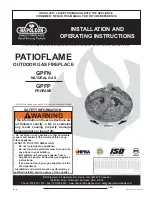
W415-0638 / C / 04.19.10
12
6.0 MAINTENANCE
6.0.1
The appliance should be inspected before initial use
and inspected and cleaned at least annually by a
qualifi ed fi eld service person.
6.0.2
Tampering is DANGEROUS and voids all warranties.
Any component that is found to be faulty, must be
replaced with an approved component.
6.0.3
To obtain proper operation, it is imperative that the
burner fl ame characteristics are steady, not lifting or
fl oating. Check the burner fl ame patterns with the
fi gure below.
6.0.4
Periodically remove the logs and examine the burner.
If dirty, clean with a soft brush. Also examine the area
around the burner air shutter. Any dirt or foreign mate-
rial, such as spider webs or nests, in this area should
be removed. This will ensure long life and trouble free
operation. When the appliance is put back in service, check the burner fl ame patterns with the fi gure
above. Reinstall the logs as shown in the log placement instructions.
6.0.5
Periodically check the hose connecting the LP gas cylinder to ensure it is not damaged in any way.
NOTE: Carbon (soot) may build up on the surface of the logs with heavy use. This is more likely to oc-
cur when using LP gas. The soot should be cleaned off the surface of the logs periodically to prevent
excessive build up. To clean the logs, be sure the fi re is out, the gas supply is turned off and the logs
are cool to the touch. The soot can then be brushed off with a dry bristle brush or cloth. Take care
while cleaning the logs as they can become damaged if mishandled. Care should be taken to dispose
of the soot and cleaning materials properly. Keep away from clothing and outdoor furniture.
During the winter months in cold weather climates, it is recommended to disconnect the Patiofl ame and store it
in a cool dry place. Do not store the propane tank inside. For the remainder of the year, protect and cover your
Patiofl ame from rain, freezing rain and snow.
6.1 HIGH ELEVATION INSTALLATION
This listed gas appliance is tested and approved for elevations from 0 to 4500 feet in Canada and the U.S.
When installing this appliance at an elevation above 4500 feet (in the U.S.), it may be necessary to decrease
the input rating by changing the existing burner orifi ce to a smaller size. Input should be reduced four percent
(4%) for each 1,000 feet beyond the 4,500 feet above sea level, unless the heating value of the gas has been
reduced, in which case this general rule will not apply. To identify the proper orifi ce size, check with the local
gas utility.
When installing this unit at an elevation above 4,500 feet (in Canada), check with local authorities.
Consult your local gas utility for assistance in determining the proper orifi ce for your location.
6.2 CLEANING STAINLESS STEEL
81.1
Stainless steel tends to oxidize or stain in the presence of chlorides and sulfi des, particularly in coastal areas
and other harsh environments, such as the warm, highly humid atmosphere around pools and hot tubs. These
stains could be perceived as rust, but can be easily removed or prevented. To provide stain prevention and
removal, wash all stainless steel surfaces every 3-4 weeks or as often as required with fresh water and/or
stainless steel cleaner.
CLEANING THE STAINLESS STEEL SURFACE:
Do not use abrasive cleaners or steel wool on the stainless steel parts. Doing so will scratch the fi nish. Sur-
faces should be cleaned with warm soapy water while the metal is still warm to the touch. To clean stainless
surfaces, use a stainless steel or non-abrasive cleaner. Always wipe in the direction of the grain. Over time,
stainless steel parts discolour when heated, usually to a golden or brown hue. This discolouration is normal
and does not affect the performance of the appliance.
Содержание GPFN
Страница 14: ...W415 0638 C 04 19 10 14 13 1 14 2 5 4 9 10 8 11 7 6 3 12 16...
Страница 15: ...W415 0638 C 04 19 10 15 8 0 SERVICE HISTORY 43 1...
Страница 16: ...W415 0638 C 04 19 10 16 44 1 9 0 NOTES...


































